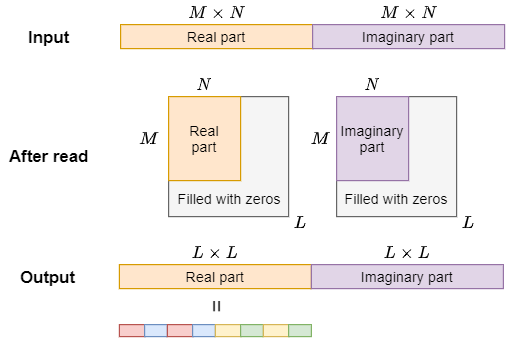fft2
Functions
-
int main(int argc, char *argv[])
fft2 [ option ] [ infile ]
-l int
FFT length \((1 \le L)\)
-r int
number of rows \((1 \le M \le L)\)
-c int
number of columns \((1 \le N \le L)\)
-o int
output format
0real and imaginary parts1real part2imaginary part3amplitude spectrum4power spectrum
-p int
output style
0standard1transposed2transposed with boundary3quadrand with boundary
infile str
double-type 2D data sequence
stdout
double-type 2D FFT sequence
The input and output are arranged as follows.

The output are reshaped by
-poption.
- Parameters:
argc – [in] Number of arguments.
argv – [in] Argument vector.
- Returns:
0 on success, 1 on failure.
-
class TwoDimensionalFastFourierTransform
Calculate 2D DFT of complex-valued input data.
The inputs are two \(M \times N\) matrices that represent real and imaginary parts:
\[ \begin{array}{cc} \mathrm{Re}(\boldsymbol{x}), & \mathrm{Im}(\boldsymbol{x}). \end{array} \]The outputs are two \(L \times L \) matrices:\[ \begin{array}{cccc} \mathrm{Re}(\boldsymbol{X}), & \mathrm{Im}(\boldsymbol{X}), \end{array} \]where \(L\) is the FFT length and must be a power of two.Public Functions
-
TwoDimensionalFastFourierTransform(int num_row, int num_column, int fft_length)
- Parameters:
num_row – [in] Number of rows, \(M\).
num_column – [in] Number of columns, \(N\).
fft_length – [in] FFT length, \(L\).
-
inline int GetNumRow() const
- Returns:
Number of rows of input.
-
inline int GetNumColumn() const
- Returns:
Number of columns of input.
-
inline int GetFftLength() const
- Returns:
FFT length.
-
inline bool IsValid() const
- Returns:
True if this object is valid.
-
bool Run(const Matrix &real_part_input, const Matrix &imag_part_input, Matrix *real_part_output, Matrix *imag_part_output, TwoDimensionalFastFourierTransform::Buffer *buffer) const
- Parameters:
real_part_input – [in] Real part of input.
imag_part_input – [in] Imaginary part of input.
real_part_output – [out] Real part of output.
imag_part_output – [out] Imaginary part of output.
buffer – [out] Buffer.
- Returns:
True on success, false on failure.
-
class Buffer
Buffer for TwoDimensionalFastFourierTransform class.
-
TwoDimensionalFastFourierTransform(int num_row, int num_column, int fft_length)